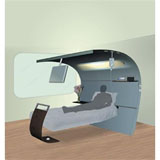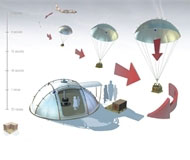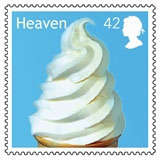Outlandish designs meet the functional at RSA Awards
Fancy flying sedated in coffin-like explosion-proof pods? Or wearing glasses that merge digital blog information with normal vision? These are just a few of the more outlandish concepts to emerge from this year’s Royal Society of Arts Design Directions Aw

Fancy flying sedated in coffin-like explosion-proof pods? Or wearing glasses that merge digital blog information with normal vision? These are just a few of the more outlandish concepts to emerge from this year’s Royal Society of Arts Design Directions Awards competition.
An exhibition showing all the winners of the student design competition from the 38 different categories goes live on-line on 30 May on www.rsadesigndirections.org.
Categories, such as Horizon Scanning and Natural Disaster Relief, were conceived for this year’s competition to encourage students to debate and create designs that would respond to changing technologies and environments. Glancing across the winning concepts, many of the designs address social needs, highlighting the fact that the award scheme, which was first begun in 1924, is no longer just about designing a functional product. However, it is hard not to conclude that many of the more bizarre and controversial of the designs will ever go beyond the concept stage.
In the Design for Debate category, Peter Humphery from Loughborough University wins for his Sedatair concept, which is based on the idea of rendering humans unconscious and transforming them into ‘human baggage’. Supposed benefits include increased security at borders, prevention of on-board terrorism, upping passenger load capacity and eradicating fear of flying.

Some of the more functional winning designs include Julie Trueman’s scheme for the Design for Patient Safety category. From the University of Salford, she has created a model for a more efficient, star-shaped hospital ward, which places an administrative hub and a nurses’ station at its centre. Frances Sorrell, chairman of this year’s judging panel, comments, ‘If developed, these ideas would make an enormous difference in improving the patient experience.’
Stuart Williamson from Northumbria University designed a parachute that can be transformed into a shelter once it lands in a disaster zone, for the Natural Disaster Relief category. It could be used for roof insulation or as a greenhouse in areas suffering from crop devastation.
In the Inclusive Worlds category, Alice Boardman, Françoise-Doffay Smith and Kirsten Elliot at Kingston University created a ‘date by touch’ system that shows when food has passed its sell-by date through the use of a petal-shaped detector. This contains chemical compounds and works by detecting the natural gases released when food deteriorates. The concept has been approved by the Food and Drug Administration, and is awaiting a patent.

For the Furniture for Real Environments category, Simon Kingston and James Rennick, at the National College of Art and Design in Dublin, created an innovative school toilet unit, designed to help tackle issues such as hygiene, bullying and maintenance. Mark Stubbington, at University College Falmouth, is one of the winners in the Postage Stamps category for his designs of Heaven and Hell reversible stamps. (pictured left)
For next year’s competition, new categories, currently being decided upon, will be introduced. RSA design programme manager Ann Crawley encourages students to focus on undertaking more extensive user-based research to meet the upcoming briefs. Entries are expected in by the end of December, but a final date has not yet been set.
-
Post a comment




